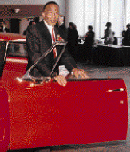
Driving While Black: The Car and Race Relations in Modern America
On the Image versus Reality
If popular culture celebrated blacks and their big cars, the lived reality of many African Americans stood in sharp contrast. Because blacks were more likely to be poor than whites (in 1960, nearly half of the nation's blacks lived beneath the poverty line), they were less likely to be able to afford new cars and, for most of the twentieth-century, they had difficulties getting car loans and paid more for insurance because of the discriminatory attitudes of bankers and actuaries. When they bought cars, most had to go to white car dealerships. Until 1940, when Ed Davis opened up a Studebaker dealership in Detroit, there were no black-owned car dealerships in the United States. In 1963, Davis became Chrysler's first black dealer--and possibly the first black to own a "Big Three" franchise. In the post-1960s years, car dealerships became an important vehicle for black upward mobility: by 1987, 53 of the top 100 black-owned companies in the United States were auto dealerships (although, as a reminder of the black-white gap in the business world, the top 100 white-owned companies dwarfed car dealerships: whites owned nearly all companies on the Fortune 500 list). Even if blacks owned more car dealerships than ever before, white-owned car dealers still dominated the market and often treated black customers unequally. As late as the 1990s, when the Urban League sent out matched pairs of black and white car buyers, they found that black consumers paid, on average, higher interest rates and higher fees than did whites who had the same income and credit history.
The automobile preferences of well-to-do blacks became the source of pernicious racial stereotypes. By the late 1960s, white, conservative critics of welfare created a powerful and enduring (even if completely fictional) image of "welfare queens" who drove Cadillacs--black single mothers who supposedly lived decadent lives off of their AFDC checks. It was, of course, impossible to pay for a new luxury car on a meager welfare check. What made the "welfare queen" stereotype so dubious was that poor blacks were far less likely to own cars than any other segment of the population.
The lack of access to reliable cars became a major contributing factor to the problem of poverty. Over the last half of the twentieth century, as metropolitan areas sprawled outward and public transportation systems faced cutbacks, access to a car became crucial to economic success. Suburban employers who sought low-wage minority employees (such as office park janitors, shopping center stockroom workers, and kitchen staff) faced a dilemma. Patterns of residential segregation by race and class meant that most black and other minority workers lived a great distance from the most-rapidly growing workplaces. In addition those workplaces were only accessible by car.
Writing in 1968, economist John Kain coined the phrase "spatial mismatch" to describe the fact that most new jobs were being created in suburban areas--only accessible by car--while the minority population was concentrated in inner cities, often distant from workplaces. By the turn of the twenty-first century, as metropolitan areas sprawled even further outward, the effects of that spatial mismatch remained pronounced in many major metropolitan areas. In sprawlng metropolitan America, access to a reliable car has remained a key to economic success. Yet studies showed that minorities were far more reliant on public transportation than whites (in 2001, 54 percent of all public transportation users in the U.S. were black and Hispanic). 87.6 percent of whites in 2001 traveled to work by car, while over 21 percent of blacks got to work by other means of transportation (including public transportation, bike, and foot). And in many large cities, high rates of insurance and problems with driver's licenses kept sizeable segments of the minority population from being able to drive cars legally or safely. The poor and especially poor minorities suffered from the effects of transportation inequality. Cars opened up opportunities to those with access to them, but the lack of reliable transportation contributed to the problem of persistent racial inequality in modern America.
<<Previous Section - Next Section>>
Introduction
The Car and Jim Crow
"Drivin' Down the Freeway": Blacks and Car Culture
Image Versus Reality
On the Line: Blacks and Auto Work
For Further Reading
Complete Text Printable View
About the Project | Credits | Contact Us | Student & Teacher Resources | Site Map
©2004-2010 Automobile in American Life and Society
